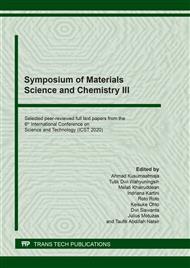[1]
Z. Xu, X. Yin, Y. Guo, Y. Pu, M. He, Ru-Doping in TiO2 electron transport layers of planar heterojunction perovskite solar cells for enhanced performance, J. Mater. Chem. C. 6 (17) (2018) 4746–4752.
DOI: 10.1039/c7tc05252a
Google Scholar
[2]
A.A.B. Ruíz, Effect of Thin TiO2 Buffer Layer on the Performance of Plastic-based Dye-sensitized Solar Cells Using Indoline Dye. (2015).
DOI: 10.5796/electrochemistry.76.158
Google Scholar
[3]
B. O'Regan, M. Grätzel, A low-cost, high-efficiency solar cell based on dye-sensitized colloidal TiO2 films, Nature. 353 (6346) (1991) 737–740.
DOI: 10.1038/353737a0
Google Scholar
[4]
A. Hagfeldt, B. Didriksson, T. Palmqvist, H. Lindström, S. Södergren, H. Rensmo, S.-E. Lindquist, Verification of high efficiencies for the Grätzel-cell. A 7% efficient solar cell based on dye-sensitized colloidal TiO2 films, Sol. Energy Mater. Sol. Cells. 31 (4) (1994) 481–488.
DOI: 10.1016/0927-0248(94)90190-2
Google Scholar
[5]
B. Li, X. Chen, T. Zhang, S. Jiang, G. Zhang, W. Wu, X. Ma, Photocatalytic selective hydroxylation of phenol to dihydroxybenzene by BiOI/TiO2 p-n heterojunction photocatalysts for enhanced photocatalytic activity, Appl. Surf. Sci. (2018).
DOI: 10.1016/j.apsusc.2017.12.220
Google Scholar
[6]
A.R. Zainun, S. Tomoya, U.M. Noor, M. Rusop, I. Masaya, New approach for generating Cu2O/TiO2 composite films for solar cell applications, Mater. Lett. 66 (1) (2012) 254–256.
DOI: 10.1016/j.matlet.2011.08.032
Google Scholar
[7]
L.M. Fraas, Y. Ma, CdS thin films for terrestrial solar cells, J. Cryst. Growth. 39 (1) (1977) 92–107.
DOI: 10.1016/0022-0248(77)90157-9
Google Scholar
[8]
A. Munshi, W. Sampath, CdTe photovoltaics for sustainable electricity generation, J. Electron. Mater. 45 (9) (2016) 4612–4619.
DOI: 10.1007/s11664-016-4484-7
Google Scholar
[9]
Q. Zhang, F. Hao, J. Li, Y. Zhou, Y. Wei, H. Lin, Perovskite solar cells: must lead be replaced–and can it be done? Sci. Technol. Adv. Mater. 19 (1) (2018) 425–442.
DOI: 10.1080/14686996.2018.1460176
Google Scholar
[10]
W.F. Yao, X.H. Xu, H. Wang, J.T. Zhou, X.N. Yang, Y. Zhang, S.X. Shang, B.B. Huang, Photocatalytic property of perovskite bismuth titanate, Appl. Catal. B Environ. 52 (2) (2004) 109–116.
DOI: 10.1016/j.apcatb.2004.04.002
Google Scholar
[11]
H. Cheng, B. Huang, K. Yang, Z. Wang, X. Qin, X. Zhang, Y. Dai, Facile template-free synthesis of Bi2O2CO3 hierarchical microflowers and their associated photocatalytic activity, ChemPhysChem. 11 (10) (2010) 2167–2173.
DOI: 10.1002/cphc.200901017
Google Scholar
[12]
H. Cheng, B. Huang, J. Lu, Z. Wang, B. Xu, X. Qin, X. Zhang, Y. Dai, Synergistic effect of crystal and electronic structures on the visible-light-driven photocatalytic performances of Bi2O3 polymorphs, Phys. Chem. Chem. Phys. 12 (47) (2010) 15468–15475.
DOI: 10.1039/c0cp01189d
Google Scholar
[13]
X. Lin, S.S. Jiang, Z. Lin, M. Wang, Y.S. Yan, The influence of g-C3N4 loading on the photocatalytic activity of Bi12O17Br2/Bi2O3 composite in the phenol red degradation, IOP Conf. Ser. Mater. Sci. Eng. 137 (1) (2016) 012020.
DOI: 10.1088/1757-899x/137/1/012020
Google Scholar
[14]
R.L.Z. Hoye, L.C. Lee, R.C. Kurchin, T.N. Huq, K.H.L. Zhang, M. Sponseller, L. Nienhaus, R.E. Brandt, J. Jean, J.A. Polizzotti, A. Kursumović, M.G. Bawendi, V. Bulović, V. Stevanović, T. Buonassisi, J.L. MacManus-Driscoll, Strongly enhanced photovoltaic performance and defect physics of air-stable bismuth oxyiodide (BiOI), Adv. Mater. 29 (36) (2017) 1–10.
DOI: 10.1002/adma.201702176
Google Scholar
[15]
A.A. Putri, A.A. Abuelwafa, S. Kato, N. Kishi, T. Soga, A simple spin-assisted SILAR of bismuth oxyiodide films preparation for photovoltaic application, SN Appl. Sci. 2 (1) (2020) 1–8.
DOI: 10.1007/s42452-019-1913-2
Google Scholar
[16]
A.A. Putri, S. Kato, N. Kishi, T. Soga, Relevance of precursor molarity in the prepared bismuth oxyiodide films by successive ionic layer adsorption and reaction for solar cell application, J. Sci. Adv. Mater. Devices. 4 (1) (2019) 116–124.
DOI: 10.1016/j.jsamd.2019.01.007
Google Scholar
[17]
K. Wang, F. Jia, Z. Zheng, L. Zhang, Crossed BiOI flake array solar cells, Electrochem. Commun. 12 (12) (2010) 1764–1767.
DOI: 10.1016/j.elecom.2010.10.017
Google Scholar
[18]
L. Zhao, X. Zhang, C. Fan, Z. Liang, P. Han, First-principles study on the structural, electronic and optical properties of BiOX (X=Cl, Br, I) crystals, Phys. B Condens. Matter. 407 (17) (2012) 3364–3370.
DOI: 10.1016/j.physb.2012.04.039
Google Scholar
[19]
Y. Park, Y. Na, D. Pradhan, B.K. Min, Y. Sohn, Adsorption and UV/Visible photocatalytic performance of BiOI for methyl orange, Rhodamine B and methylene blue: Ag and Ti-loading effects, CrystEngComm. 16 (15) (2014) 3155–3167.
DOI: 10.1039/c3ce42654h
Google Scholar
[20]
J. Cao, B. Xu, H. Lin, B. Luo, S. Chen, Novel heterostructured Bi2S3/BiOI photocatalyst: Facile preparation, characterization and visible light photocatalytic performance, Dalt. Trans. 41 (37) (2012) 11482–11490.
DOI: 10.1039/c2dt30883e
Google Scholar
[21]
M. Long, P. Hu, H. Wu, Y. Chen, B. Tan, W. Cai, Understanding the composition and electronic structure dependent photocatalytic performance of bismuth oxyiodides, J. Mater. Chem. A. 3 (10) (2015) 5592–5598.
DOI: 10.1039/c4ta06134a
Google Scholar
[22]
W. Fan, H. Li, F. Zhao, X. Xiao, Y. Huang, H. Ji, Y. Tong, Boosting the photocatalytic performance of (001) BiOI: enhancing donor density and separation efficiency of photogenerated electrons and holes, Chem. Commun. 52 (30) (2016) 5316–5319.
DOI: 10.1039/c6cc00903d
Google Scholar
[23]
M. Fang, H. Jia, W. He, Y. Lei, L. Zhang, Z. Zheng, Construction of flexible photoelectrochemical solar cells based on ordered nanostructural BiOI/Bi2S3 heterojunction films, Phys. Chem. Chem. Phys. 17 (20) (2015) 13531–13538.
DOI: 10.1039/c4cp05749j
Google Scholar
[24]
Y. Lei, L.D. Zhang, J.C. Fan, Fabrication, characterization and Raman study of TiO2 nanowire arrays prepared by anodic oxidative hydrolysis of TiCl3, Chem. Phys. Lett. 338 (4–6) (2001) 231–236.
DOI: 10.1016/s0009-2614(01)00263-9
Google Scholar
[25]
R. He, J. Zhang, J. Yu, S. Cao, Room-temperature synthesis of BiOI with tailorable (001) facets and enhanced photocatalytic activity, J. Colloid Interface Sci. 478 (2016) 201–208.
DOI: 10.1016/j.jcis.2016.06.012
Google Scholar


